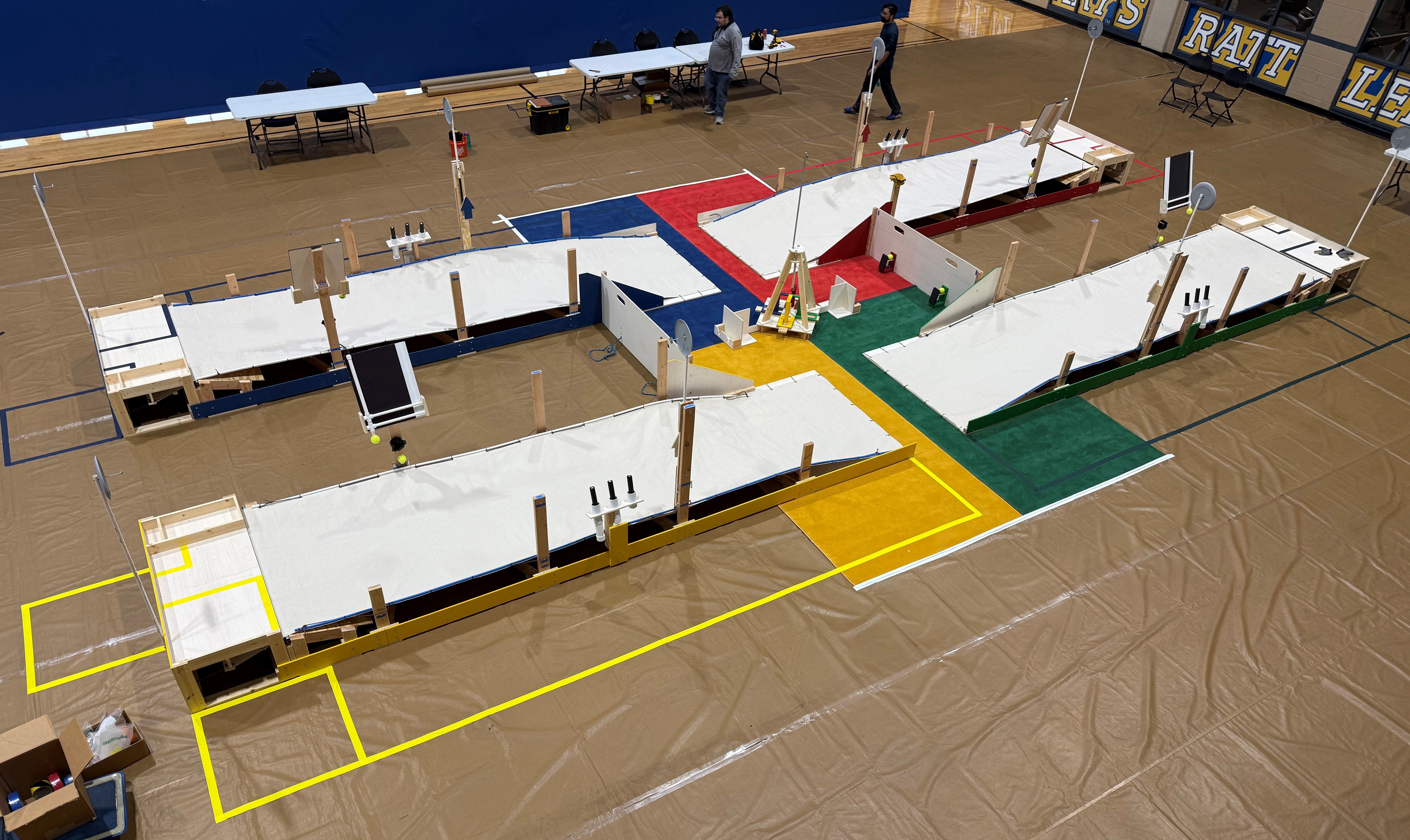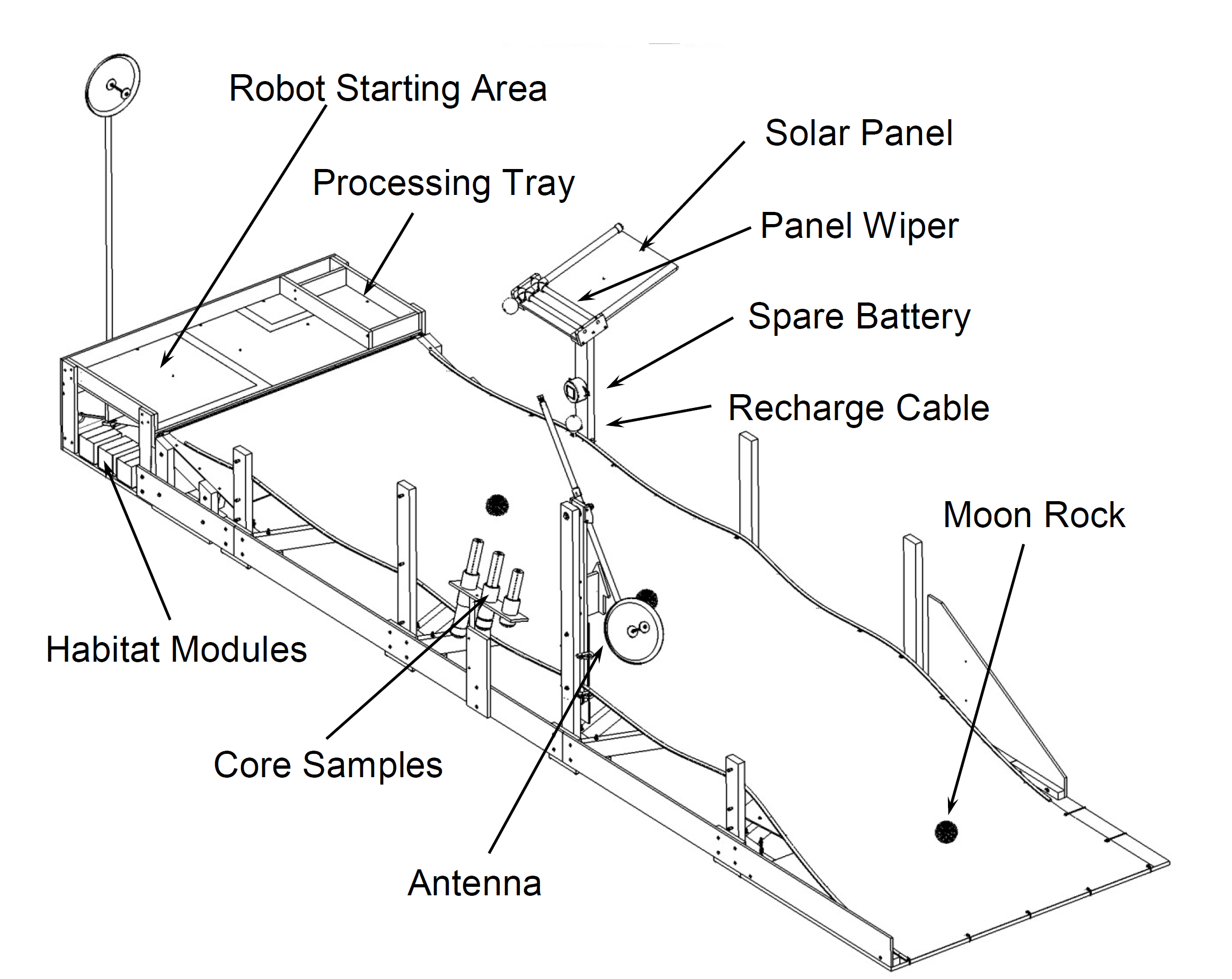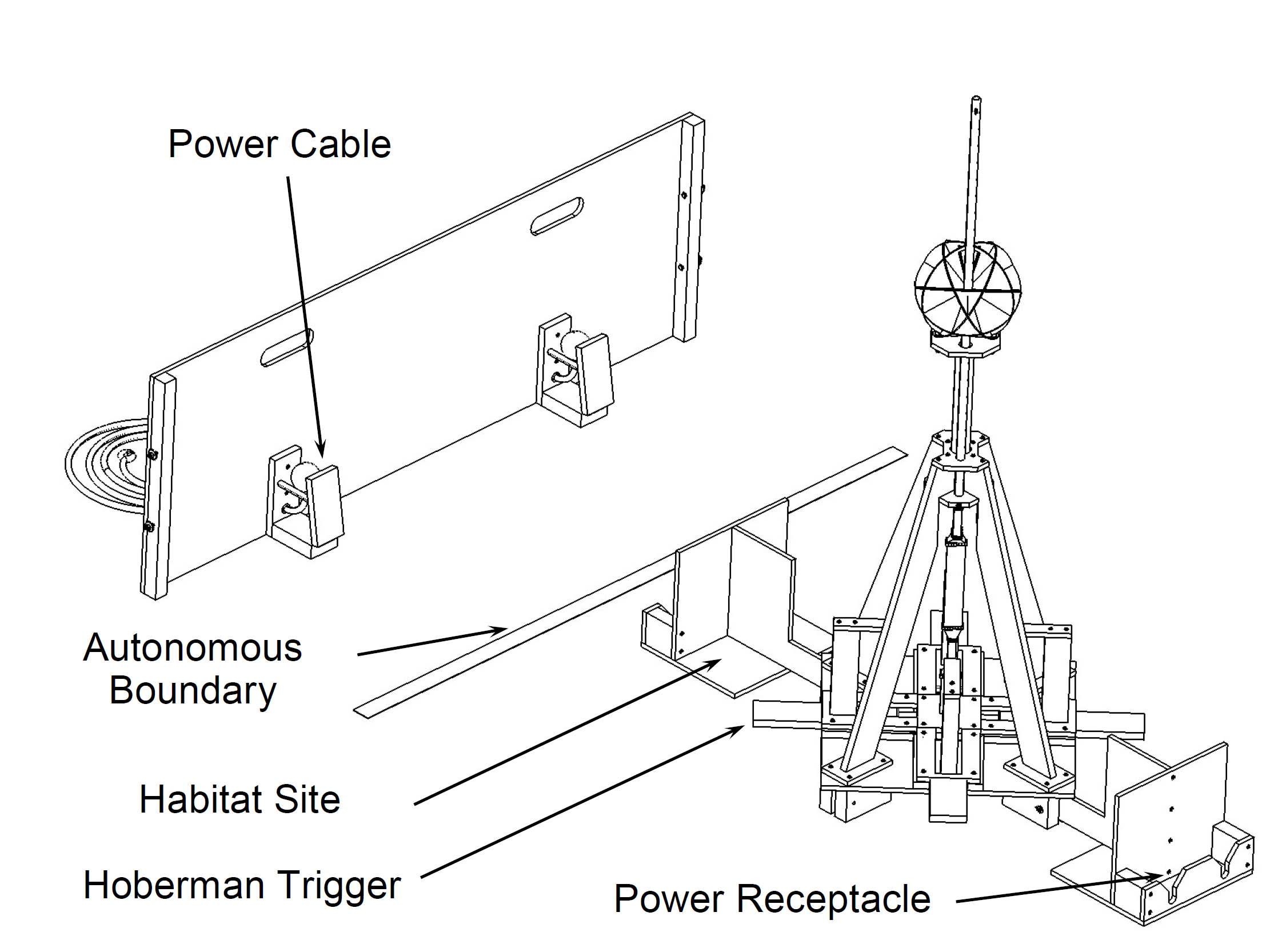The field is divided into four quadrants and a central area. Each team is assigned to a quadrant for the match and only the assigned team may drive their robot within that quadrant. The central area is shared by all teams.

Each quadrant consists of a Lunar Lander Platform, which includes a robot starting area with a processing tray, and a flexible lunar surface with multiple tasks along the lunar surface. The Lunar Lander Platform also includes habitat modules and an astronaut that can ride on the team’s robot.
The lunar surface tasks include:
- A solar power station that includes:
- A solar panel to be reoriented.
- A dust wiper to clean the solar panel.
- A spare robot battery to be carried by the robot.
- A recharge cable to be carried by the robot.
- Three different length core samples to be removed and returned to the processing tray.
- An antenna that needs to be deployed. Once deployed, the spotter may utilize the expanded spotter box.
- Three moon rocks that can be returned to the starting area or processing tray.

Scoring for the lunar surface tasks are given in the table that follows:
|
Task |
Points |
|
Moon rock placed on lunar lander platform |
3 |
|
Moon rock placed in processing tray |
10 |
|
Core sample in processing tray |
13 |
|
Antenna deployed |
15 |
|
Solar panel reoriented |
25 |
|
Solar panel cleaned |
15 |
|
Spare battery retrieved |
8 |
|
Recharge cable connector on robot |
30 |
The lunar surface is constructed from a suspended canvas tarp that can be configured in three different shapes. Each team designates the lunar surface configuration for their particular quadrant for each match and the configuration affects the value of items scored in the lunar surface area:
|
Surface Configuration |
Multiplier |
|
Easy Setting |
1 |
|
Moderate Setting |
2 |
|
Hard Setting |
3 |
The central shared area represents the Central Basin Crater and includes the Hoberman habitat site as well as team-specific power connections that are located in the Permanently Shaded Region (behind a wall). The Hoberman sphere can be deployed by the first team to actuate their color-coded trigger. Teams can place habitat modules into any of the designated areas on the habitat site. Three modules are initially located under each Lunar Lander Platform and can be placed on the robot by the spotter. Each team has a habitat power cable located at the edge of the crater that can be captured and installed into the corresponding power receptacle on the habitat site. Teams can choose to retrieve the power connector autonomously for additional points.

Scoring in the Central Basin Crater is detailed in the table that follows.
|
Action |
Points |
|
Place Habitat Module at Level 1 |
30 |
|
Place Habitat Module at Level 2 |
40 |
|
Place Habitat Module at Level 3 |
50 |
|
Retrieve Power Cable (Driver Control) |
40 |
|
Retrieve Power Cable (Autonomous) |
100 |
|
Connect Power Cable |
60 |
|
Deploy Hoberman Sphere |
35 |
Other scoring opportunities exist for:
- Having the astronaut remain on-board the robot for the entire match: 50 points
- Returning to the robot start area at the end of the match: 30 points
- Contributing to a habitat module stack consisting of different colors: 50 points (per team, per stack)
Teams have constructed their machines subject to a list of allowable materials and other rules on construction, as well as initial size and weight limits. There are also numerous restrictions on how the game is played. A partial list of restrictions includes:
- Robots may not attempt to take game pieces that are being grasped by another robot.
- Robots may not remove game pieces that have been placed in a scoring position by another team.
- Robots may not interfere with another robot that is operating autonomously.
- Aggressive/malicious actions may result in a penalty or elimination from the match.
- There will be three phases to the contest: a partial round robin seeding competition, a six-game round robin semi-final between the top eight teams, and a four-game round robin final between the top four teams
During the seeding competition, each team will play seven games against randomly selected opponents. The team’s average score (after the lowest score is dropped) during the seeding competition will be used to rank the team and to determine seven of the eight teams that will advance to the semi-final round robin playoff.
The eighth team for the semi-finals will be the highest scoring team during a “wildcard” game. The participants for the wildcard game are selected based on the score of their engineering notebook. All teams are required to turn in an engineering notebook documenting the development and design of their robot. This notebook is a significant portion of the BEST Award, and the wildcard game gives teams further incentive to turn in quality notebooks by rewarding them for their effort.
At the start of the semi-finals, the scores will be reset to zero. For the semi-final round robin playoff, the top eight teams will each play three matches. The total of each team’s scores for these three matches will determine which four teams advance to the finals. For the final competition, total scores will again be reset to zero. The top four teams will play four additional matches to determine the final ranking order.
San Antonio BEST Award Results
- Spring Branch Middle School
- JB Alexander High School
- Hill Country College Preparatory High School
- Holy Cross of San Antonio
- Memorial Early College High School
- United Engineering and Technology Magnet
- Sandra Day O'Connor High School
- William Howard Taft High School
Competition Results
- Hill Country College Preparatory High School
- Spring Branch Middle School
- Sandra Day O'Connor High School
- JB Alexander High School
- William Howard Taft High School
- Holy Cross of San Antonio
- Pieper High School
- Lackland ISD
Other Awards
- BEST T-Shirt Award - Lyndon B Johnson High School
- Founders Award -
- Canyon Lake High School
- Sandra Day O'Connor High School
- Most Robust Award - Hill Country College Preparatory High School
- Good Lookin' John Wigand Most Photogenic - Memorial Early College High School
- Most Spirit Award - JB Alexander High School
- Most Sportsmanship Award - Spring Branch Middle School
- Best Table Display and Interview - Smithson Valley Middle School
- Best Use of Game Theme - Holy Cross of San Antonio
- Blood, Sweat, and Duct Tape - Brennen High School
- SAME Award - Lackland ISD
Additional information on the Award Results and the Game Results are available.
Teams Advancing to State Competition
UIL State Championship
- Small School: Lackland ISD
- Medum School: Hill Country College Preparatory High School
- Large Schools: JB Alexander High School and United Engineering and Technology Magnet
Texas BEST Teams Advancing via BEST Award:
- Spring Branch Middle School
- Holy Cross of San Antonio
- Sandra Day O'Connor High School
Texas BEST Teams advancing via Game Score:
- William Howard Taft High School
- Pieper High School
